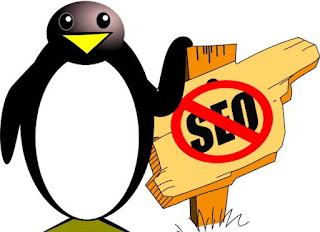As we all know, Google is a pioneer, and the world leader in internet
search. It owns around 2/3rd (66%) of the shares in the industry at the
time of this writing, making it bigger than any other internet company.
It has been around for quite some time now, and has been updating its
search functionality regularly. Since the past few years though, we have
seen some radical changes in its search model. For example, it was only
last year that the dreaded Panda update was unleashed onto the world!
And these days, everyone is talking about the new Penguin update that
rolled out just a few days back. Head of Google's web-spam team, Matt
Cutts tweeted a picture of a stuffed penguin along with a stuffed panda.
How cute :). Or is it?
Some people would agree. But many will say quite the contrary. These
animals are supposed to give out a friendly image about the updates.
They are monsters in disguise though! Many websites have been punished
and penalized by these two. So what actually are they all about? And how
do they effect websites?
So why are these updates needed?
If this is about any one thing, it's about Quality Content vs Search Engine Optimization
(SEO). The concept of SEO has evolved ever since search engines like
Google have come along. SEO is good. It allows you to take your website
ranking to a higher level. But that's precisely where the problem lies.
You see, it provides a shortcut where you can skip writing quality
content, and still be able to take the low quality content to a high
ranking. In late 90s and early 2000s, when Google was still newborn,
some webmasters started doing just that. They would spare themselves the
trouble of writing good quality content, and would learn SEO tricks instead, which brought their poor quality content to the top.
Through he years, search engine optimizers kept at it. Google has been
constantly improving its search module, but these people learned to duck
and dodge everything Google had to throw at them. Fundamentally, this
practice defeats the basic goal of Google, which is to provide good
quality content to readers, instead of bogus websites that spam the web
and gain the high ground in SERPs (Search Engine Results Pages). Hence,
the need for an advanced screening mechanism which would let quality
through but not spam content.
Although Google has been implementing such a filter throughout the past
few years, it only rolls out major algorithm updates once a year. Google
Panda was just such an update last year. And may I say, it was the
deadliest update yet. The major update for this year is the Google
Penguin update, and it looks relatively less harmful than Panda,
although it still has effected a lot of websites. So basically, these
updates are aimed at promoting quality and filtering out spam.
Google Panda
Google unleashed the Panda on Feb 24 2011. And immediately, it made its
mark and hit so many blogs and websites that the entire ranking
structure was shaken, with new websites coming at the top while some old
established websites dipping down. According to Google, it was aimed at
filtering "thin or low quality content". Since its launch, Google have
made changes to it 13 times as of 20th April 2012. And a total of 12%
websites have been effected by this update.

Google Penguin
Google Penguin is another installment in Google's arsenal of weapons to
be unloaded onto the online world. This was introduced on 24th April
2012. Again, it aimed at discouraging / punishing spam websites. By far,
it has effected about 3% of the websites. Prior to its release, Google
said;
In the next few days, we’re launching an important algorithm change targeted at web spam. The change will decrease rankings for sites that we believe are violating Google’s existing quality guidelines. We’ve always targeted web spam in our rankings, and this algorithm represents another improvement in our efforts to reduce webspam and promote high quality content. While we can’t divulge specific signals because we don’t want to give people a way to game our search results and worsen the experience for users, our advice for webmasters is to focus on creating high quality sites that create a good user experience and employ white hat SEO methods instead of engaging in aggressive webspam tactics.
In the next few days, we’re launching an important algorithm change targeted at web spam. The change will decrease rankings for sites that we believe are violating Google’s existing quality guidelines. We’ve always targeted web spam in our rankings, and this algorithm represents another improvement in our efforts to reduce webspam and promote high quality content. While we can’t divulge specific signals because we don’t want to give people a way to game our search results and worsen the experience for users, our advice for webmasters is to focus on creating high quality sites that create a good user experience and employ white hat SEO methods instead of engaging in aggressive webspam tactics.

Panda and Penguin penalty
Once again, these updates are aimed at punishing spam websites, although
there could be a lot more reasons for the updates to hit your site.
Sites that are hit have seen a demotion in their Google PageRank, and
their traffic has dipped, while sites that have benefited from this
update have seen a soar in their traffic. The saying "One man's gain is
another man's loss" never seemed more appropriate.
Why have you been effected ?
There can be many reasons why you got hit. But the exact factors are
known only to Google insiders. Google doesn't disclose this information,
because if they do, search engine optimizers would grab on to those
points and cheat Google once again. So Google does not give out the
precise details, thank you very much. Here are, however, some probable
causes as to why you took a hit.
- Over optimization - This is very important. People who don't have quality content over optimize their websites. So you should do what is necessary, and no more!
- High keyword density - This is like calling out loud to search engines; "check me! check me! I have the most keywords!". And they don't like it when you call them. Using excessive keywords is also a form of spamming, since you are seeking for search engines' attention. In the past, pages were ranked according to the number of keywords they had. Not anymore though. Always keep that in mind.
- Virus and malware - People simply hate it when they land on a website infected with a virus. And so does Google. Having a virus on your site, or even having too many spam or bot scripts can trigger the alarm bells for Google. Please review your website regularly from now on.
- Lack of user experience - Now this is very crucial, and Google has been stressing on this a lot lately. Pleasing the search engine is one thing. Pleasing the visitors is another. Even with adequate SEO, a website that lacks a good user experience might have been hit by Google.
- Duplicate / copied content - Yeah you think you are making things easier for yourself when copying content, but actually, you aren't. In fact, quite the contrary, you are axing your own feet. Google hates it when it finds duplicate content on your website. Never copy from another source, and never use redundant content.
- High Bounce Rate - Make sure to reduce the number of banners and other heavy graphics as much as possible to make sure your site loads faster. Slow loading blogs are hated by visitors and so by Google. Do not reduce the size of the page so much that it may begin looking dull and grey. Be creative yet smart!
These were some of the tips we had for you. This is the first post in a
series that looks into these updates from Google in more detail. We will
discuss reasons for failure (in more detail), how to avoid them, and
best practices. We also hope to prepare you for the next major Google
update. So stay tuned, and give us your feedback in the comment section
below.


0 comments: